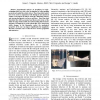Free Online Productivity Tools
i2Speak
i2Symbol
i2OCR
iTex2Img
iWeb2Print
iWeb2Shot
i2Type
iPdf2Split
iPdf2Merge
i2Bopomofo
i2Arabic
i2Style
i2Image
i2PDF
iLatex2Rtf
Sci2ools
IROS
2009
IEEE
2009
IEEE
Biorobotic fins for investigations of fish locomotion
Abstract—Experimental analyses of propulsion in freelyswimming fishes have led to the development of self-propelling pectoral and caudal fin robotic devices. These biorobotic models have been used in conjunction with biological and numerical studies to investigate the effects of the fin’s kinematic patterns and structural properties on forces and flows. Data from both biorobotic fins will be presented and discussed in terms of the utility of using robotic models for understanding fish locomotor dynamics. Through the use of the robotic fins, it was shown that subtle changes to the kinematics and/or the mechanical properties of fin rays can impact significantly the magnitude, direction, and time course of the 3d forces used in propulsion and maneuvers.
| Added | 24 May 2010 |
| Updated | 24 May 2010 |
| Type | Conference |
| Year | 2009 |
| Where | IROS |
| Authors | James L. Tangorra, Christopher J. Esposito, George V. Lauder |
Comments (0)

